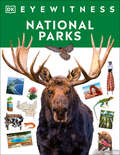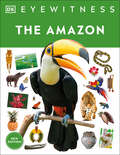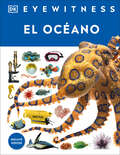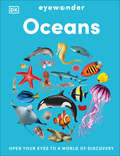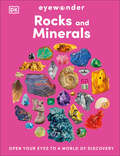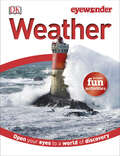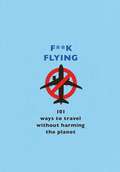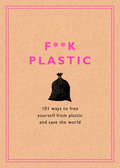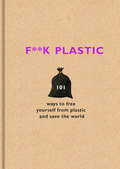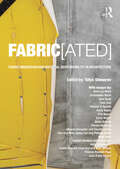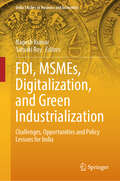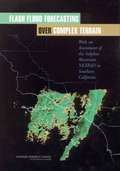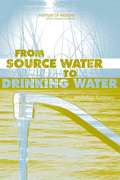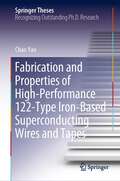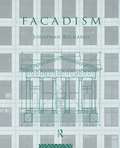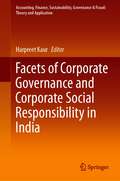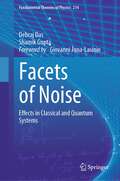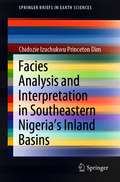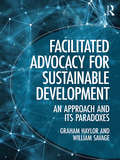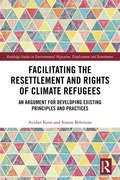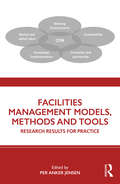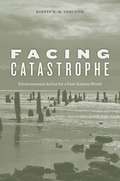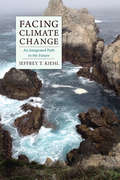- Table View
- List View
Eyewitness National Parks (DK Eyewitness)
by DKPacked with stunning photography, Eyewitness National Parks explores the history of all 63 US National Parks, and their countless treasures. Become an eyewitness to every US National Park in this picture-led reference guide that will take you on a visual tour of around 3.5 percent of the country&’s land. Through this book, explorers ages 9–12 years old can visit each National Park – from the icy windswept ranges of Wrangell-St Elias in Alaska to the sandy plains of Death Valley, the coral reefs of American Samoa, and the vast mangroves of the Everglades.This unique, beautifully illustrated guide reveals nearly 85 million acres of America&’s very popular National Parks. With striking full-color photographs, kids can marvel at landmarks such as the Colorado River winding down the Grand Canyon or the Old Faithful spraying steam in Yellowstone, and much more!Throughout the pages of this book on US National Parks, you can expect to find: - A fresh new look, new photographs, updated information, and a new &“eyewitness&” feature.- Amazing facts, updated diagrams, statistics, and timelines.- Brand new eyewitness accounts from experts in the field.Eyewitness National Parks introduces the ultimate guide to every National Park across the United States. Children can learn every unique and incredible space, with its own history, natural wonders, animals, plants, and places. This all-encompassing guide to National Parks is a must-have for curious children aged 9+ with a thirst for learning, as well as teachers, parents and librarians.So, what&’s new? Part of DK&’s best-selling Eyewitness series, this popular title has been reinvigorated for the next generation of information-seekers and stay-at-home explorers, with a fresh new look, up to 20 percent new images, including photography and updated diagrams, updated information, and a new &“eyewitness&” feature with fascinating first-hand accounts from experts in the field.Explore the series!Globally, the Eyewitness series has sold more than 50 million copies over 30 years. Learn about one of the most important events in US history with Eyewitness American Civil War, understand the incredible systems that keep your body functioning with Eyewitness Human Body or take a trip aboard the most famous ship in history with Eyewitness Titanic.
Eyewitness The Amazon: The Quest For El Dorado (DK Eyewitness)
by DKVisit one of the most incredible natural environments in this picture-packed guide, to discover the Amazon&’s plants and wildlife, and its people.Become an eyewitness to the fascinating species that live in the depths of the Amazon rainforest, in this picture-led reference guide that will take you on a visual tour of the nine South American countries it extends across.Children can journey down the River Amazon and explore the world&’s largest rainforest in this unique, beautifully illustrated guide to the beauty and diversity of the rainforest and the river, its flora and fauna, and the people who live in the region. Using striking full-color photographs and illustrations, kids can discover why this ecosystem is so important to the whole world along with amazing facts, diagrams, and statistics to see the Amazon as never before.Throughout the pages of this newly- revised book on the Amazon, you can expect to find: - A fresh new look, new photographs, updated information, and a new &“eyewitness&” feature- Amazing facts, infographics, statistics, and timelines- Brand new eyewitness accounts from experts in the fieldEyewitness Amazon introduces the most biodiverse tropical rainforest in the world and the vast river that winds its way through it. Children can discover the rainforest&’s fascinating birds, animals, insects and much more, through amazing facts, diagrams, and statistics to see the Amazon as never before. This all-emcompassing rainforest guide is a must-have for curious children aged 9+ with a thirst for learning, as well as teachers, parents and librarians.So, what&’s new? Part of DK&’s best-selling Eyewitness series, this popular title has been reinvigorated for the next generation of information-seekers and stay-at-home explorers, with a fresh new look, up to 20 percent new images, including photography and updated diagrams, updated information, and a new &“eyewitness&” feature with fascinating first-hand accounts from experts in the field.Explore the series!Globally, the Eyewitness series has sold more than 50 million copies over 30 years. Join the journey to combat climate change with Eyewitness Climate Change or take a trip aboard the most famous ship in history with Eyewitness Titanic.
Eyewitness: El océano (DK Eyewitness)
by DK¡Observa de cerca el mundo de los océanos a través de impactantes imágenes!¿Por qué el mar es azul y salado? ¿Cuántas especies de peces existen? ¿Cómo se esconden los peces para protegerse de sus depredadores? Conoce a los cangrejos ermitaños, aprende cómo se mueven los pulpos y descubre cómo se forman las olas o qué submarinos han explorado los naufragios y las trincheras más profundas.Este enciclopedia visual para niños, incluye:-Fotografías a todo color de animales marinos, entre las que se incluyen secuencias de comportamiento de los animales y diagramas de cómo funcionan los océanos.-Un montón de datos interesantes e información veraz y contrastada.-Infografías, estadísticas y cronogramas que revelan todos los aspectos y características de este bioma marino.-Relatos de expertos en la materia que fueron testigos de sucesos que tuvieron lugar en el fondo del mar o que están relacionados con los océanos.Dos tercios de nuestro planeta se compone de agua. Los océanos nos alimentan, regulan nuestro clima y producen la mayoría del oxígeno que respiramos, ¡por eso son tan importantes para la vida en la Tierra! Con Eyewitness El océano, descubrirás sus secretos, los últimos avances en exploración oceánica y a los exploradores detrás de descubrimientos tanto antiguos como nuevos. Aprende qué océanos están en peligro, qué especies marinas viven en corales y rocas, ¡y mucho más!Una herramienta imprescindible para niños curiosos mayores de 9 años con ganas de aprender sobre la vida y la historia de los océanos, así como para profesores y padres que quieran ofrecerles apoyo.Become an eyewitness to the world’s oceans and explore everything from shores and reefs to the freezing depths.Discover the watery world that covers two-thirds of the globe and find out why oceans are so important to life on Earth.Meet jet-propelled octopuses and hermit crabs, look closely at seaweed, find out how waves form and discover the submarines and submersibles that have explored shipwrecks and the deepest trenches. Learn about prehistoric oceans and find out how people are trying to protect the oceans of the future.Loved and trusted for over 30 years, Eyewitness has a new look and even more content:-A bite-sized formula of text with images that kids love!-Fully revised and fact-checked by subject specialists-Packed with facts, infographics, statistics, and timelines-Updated with brand new eyewitness accounts from experts in the fieldEyewitness Ocean uses a groundbreaking visual layout that makes learning fun for kids aged 9-12. Discover the sequences of sea animal behaviour, diagrams of how oceans work, and maps along with amazing facts, infographics, statistics, and timelines to reveal the many aspects of this marine.
Eyewonder Oceans: Open Your Eyes to a World of Discovery (Eye Wonder)
by DKSpark the love of learning with this picture-packed guide to the Earth’s oceans for children.DK's best-selling Eyewonder series is back and has been refreshed for the next generation of young readers aged 5-7.This picture-led reference guide will take you on a visual tour of the biggest habitats on our planet. Stay-at-home explorers will feel inspired by the dramatic photographs, up-to-date information, and fact-packed pages, and a brand-new "eyewonder" feature where knowledge meets real-world application.Throughout the pages of this newly revised book on oceans, you can find: Fully updated and revised content for children starting to develop a passion for science.Eye-catching photographs that grab the attention of young readers and keep them coming back for more.Engaging facts, simple explanations, and fun activities throughout the book.Eyewonder Oceans introduces children to the incredible world of marine life, the darkest depths and even the polar regions. Children can witness the wonders of the ocean floor and learn how different sea creatures live together in harmony in this refreshed guide.Explore the series!The Eyewonder series is back and better than ever, with a fresh new look and the latest information. If you liked Eyewonder Oceans, why not dig into Eyewonder Rocks and Minerals or Eyewonder Human Body?
Eyewonder Rocks and Minerals: Open Your Eyes to a World of Discovery (Eye Wonder)
by DKSpark the love of learning with this picture-packed guide to Earth’s rocks and minerals for children.DK's best-selling Eyewonder series is back and has been refreshed for the next generation of young readers aged 5-7.This picture-led reference guide will take you on a visual tour of the amazing treasures right under your feet. Stay-at-home explorers will feel inspired by the dramatic photographs, up-to-date information and fact-packed pages, and a brand-new "eyewonder" feature where knowledge meets real-world application.Throughout the pages of this newly revised book on rocks and minerals, you can find: Fully updated and revised content for children starting to develop a passion for science.Eye-catching photographs that grab the attention of young readers and keep them coming back for more.Engaging facts, simple explanations, and fun activities throughout the book.Eyewonder Rocks & Minerals introduces children to the incredible world of precious stones, different rock types, and even rocks from space. Children can discover how rocks form, find out what minerals are, and explore the hundreds of uses we have for them in this refreshed guide. Explore the series!The Eyewonder series is back and better than ever, with a fresh new look and the latest information. If you liked Eyewonder Rocks and Minerals, why not dive into Eyewonder Oceans or Eyewonder Human Body?
Eyewonder: Open Your Eyes to a World of Discovery (Eye Wonder)
by DKThe weird and wonderful weather of our planet is brought to life in Eye Wonder: Weather. This updated and revised edition is the perfect introduction to the exciting world of weather, from rain, sun, and wind to hurricanes, snow storms, and twisters, and also gives the facts about climate change, how we predict the weather, the differences in clouds, and why we have changing seasons.A precursor to DK's award-winning Eyewitness series, Eye Wonder was specially developed for children aged 5+, featuring astonishing photography exhibiting subjects within their natural setting and offering a whole new level of information through powerful images.Learn about science, history, and the natural world through beautiful photography and lively, age-appropriate text. The Eye Wonder series organizes information in a way that's easy to search, easy to read, and easy to learn.
F**k Fast Fashion: 101 ways to change how you shop and help save the planet
by The F TeamDid you know that over 300,000 tonnes of clothing are sent to landfill in the UK alone every year? And that the industry's carbon emissions are bigger than the world's flight and shipping footprints combined? But, it's OK...YOU CAN MAKE A CHANGEIn this book, you'll find 101 simple tips and tricks you as an individual can do in your everyday life to shop better and help save the planet. Governments, retailers and organisations around the world are finally starting to take action, but while we wait, let's get started. In this proactive illustrated book, you'll find 101 simple ways to change your spending habits covering: - SHOPPING: e.g. unless you live within walking distance of the shop, buy online! Delivery vans act like public transport for clothes so are much better for the environment than us driving to shops individually. - BUYING e.g. think 30 - would you wear this at least 30 times?- WEARING e.g. don't overfill your washing machine! It causes your clothes to rub together so they fade faster.- REUSING e.g. upcycle old clothes with new buttons or even embroidery if you're crafty.We've said NO to plastic, it's time to say the same to fast fashion.
F**k Flying: 101 eco-friendly ways to travel
by The F TeamThis book will show you all the ways YOU can change how you travel to help save the planet.As we come out of lockdown, many of us are thinking about getting out of the house and going on holiday but it's never been more important to think about how we get from A to B. Packed with 101 tips and tricks to reducing your carbon footprint when you're on the go, this practical little book shows that everybody can do something to protect our environment. From how you travel to work, head to the shops, go on holiday and more, this book is a must-read for everyone.Why do we need to act now? Aviation alone accounts for at least 2% of global carbon emissions and an economy-class return flight from London to NYC emits the equivalent CO2 of 11% of the average annual emissions of someone in the UK. We can all make a change and contents includes:- EVERYDAY TRAVEL (including commuting, shopping and getting around)- PLANNING (how to plan an eco-friendly holiday)- PACKING (savvy tips to pack with the planet in mind)- TO FLY OR NOT TO FLY? (lots of alternatives to flying)- WHEN YOU GET THERE (how to be a green tourist)No change is too small to make a difference.
F**k Plastic: 101 Ways to Free Yourself from Plastic and Save the World
by Rodale SustainabilityThe Zero-Waste Guide to Life!Is the thought of the 51 trillion pieces of plastic in our oceans keeping you up at night? Don't panic! The war on plastic has begun and you can help. In this book you'll find 101 little things you as an individual can do to avoid single-use plastics and help save the world. You'll find sweet and simple ideas like carrying around your own cutlery, getting ice cream in a cone instead of a cup, and buying loose doughnuts or pastries for snacks instead of packaged sweets. Plus, you'll find 101 simple ways to cut plastic from:-FOOD AND DRINK: freeze fresh veggies rather than buying frozen ones, and buy beeswax wrap instead clingfilm-AROUND THE HOUSE: buy bars of soap instead of hand dispensers and swap scourers for natural cloths-YOUR LIFESTYLE: how to throw a plastic-free party and find good plastic-free make-upWith easy, no-nonsense steps for cutting plastic out of your everyday life, this is the perfect gift for anyone ready to start fighting the war on plastic. These easy nudges will guide you to change your habits bit by bit so that cutting out plastics becomes second nature.
F**k Plastic: 101 ways to free yourself from plastic and save the world
by The F TeamIs the thought of the 51 trillion pieces of plastic in our oceans keeping you up at night? Don't panic! The war on plastic has begun and you can help! In this book you'll find 101 little things you as an individual can do to avoid single-use plastics and help save the world.Governments, brands and corporations around the globe are on the case to solve the plastic epidemic, but whilst we wait for the effects of those initiatives to trickle through and alternatives to plastic to be found, let's hit the ground running. In this proactive illustrated book, you'll find 101 simple ways to cut plastic from:-FOOD AND DRINK e.g. freeze fresh veg rather than buying frozen, and buy beeswax wrap over clingfilm- AROUND THE HOUSE e.g. buy bars of soap instead of hand dispensers and swap scourers for natural cloths- YOUR LIFESTYLE e.g. how to have a plastic-free party and find good plastic-free make-upTogether we can save our oceans - and we will!
FABRIC[ated]: Fabric Innovation and Material Responsibility in Architecture
by Tolya StonorovFABRIC[ated] examines fabric as a catalyst for innovation, reflection, change and transformation in architecture. This book explores the ways in which research and development of fabric can, and historically has, influenced and revolutionized architecture, teaching and design. Responsive, flexible, impermanent, fluid and adaptive—fabric interacts with, and influences architecture, offering innovative solutions and increased material responsibility. Foundation and theory chapters establish clear precedent and futures for fabric’s position in architectural discourse. The case study section examines 14 international projects through three different threads: Veiling, Compression and Tension. Case studies include a diverse range of projects from the HiLo unit at Nest and CAST’s fabric formed concrete projects to a discussion of the impact of fabric on SO-IL and Kennedy Violich Architect’s professional work, demonstrating new and fresh methods for addressing sustainability and social justice through the use of fabric in architecture. Through the work of the many authors of this book, we see fabric as drape, skin, veil, mold, concept and inspiration. Fabric, in its broadest definition, is an important and innovative material in the development of socially conscious architecture. Offering readers pedagogical and practical models for international projects highlighting fabric’s use in architecture, this book will appeal to the novice and the expert, architecture students and practitioners alike.
FDI, MSMEs, Digitalization, and Green Industrialization: Challenges, Opportunities and Policy Lessons for India (India Studies in Business and Economics)
by Nagesh Kumar Satyaki RoyThis book presents fresh research on how Foreign Direct Investments (FDI), Micro, Small and Medium Enterprises (MSMEs), patterns of clustering, digitalization and innovation policies, interact and influence India’s industrialisation and its greening or sustainability. As India seeks to accelerate its process of industrialization especially focusing on the manufacturing sector, different interactions between agents of industrialization need to be understood better through evidence-based research. The volume through its 17 original contributions, focuses on three broad interrelated themes: FDI, export performance, innovation and environmental sustainability; growth, competitiveness and spatial distribution of MSMEs concerning access to finance, digitalisation and sustainability; and, green technology, circular economy and challenges towards clean transition and green industrialization. Research presented in this book does not see industrialization as an isolated process from globalization and appreciates the need to act upon specific impacts of foreign trade and investments. With a focused and futuristic approach towards industrialisation in India, it provides rigorous evidence-based treatment of complex interactions using secondary and primary sources of data deploying appropriate analytical techniques. In light of empirical findings, each chapter comes up with policy lessons for industrial strategy. Shedding new light and evidence, this book makes an important contribution by helping to generate a better understanding of the process of green industrialization and how it can be fostered to create inclusive and sustainable prosperity. It will be an invaluable resource for policymakers, analysts, researchers and students of industrial and environmental economics.
FLASH FLOOD FORECASTING OVER COMPLEX TERRAIN: With an Assessment of the Sulphur Mountain NEXRAD in Southern California
by National Research Council of the National AcademiesThe nation's network of more than 130 Next Generation Radars (NEXRADs) is used to detect wind and precipitation to help National Weather Service forecasters monitor and predict flash floods and other storms. This book assesses the performance of the Sulphur Mountain NEXRAD in Southern California, which has been scrutinized for its ability to detect precipitation in the atmosphere below 6000 feet. The book finds that the Sulphur Mountain NEXRAD provides crucial coverage of the lower atmosphere and is appropriately situated to assist the Los Angeles-Oxnard National Weather Service Forecast Office in successfully forecasting and warning of flash floods. The book concludes that, in general, NEXRAD technology is effective in mountainous terrain but can be improved.
FROM SOURCE WATER TO DRINKING WATER: Workshop Summary
by Medicine Research Roundtable on Environmental Health SciencesInformation on the movement from source water to drinking water
Fabrication and Properties of High-Performance 122-Type Iron-Based Superconducting Wires and Tapes (Springer Theses)
by Chao YaoThis book addresses new ways to optimize the fabrication process and performance of iron-based superconducting wires and tapes based on the powder-in-tube (PIT) method. Further, it systemically analyzes and enhances the current-carrying ability of wire and tape conductors with regard to chemical addition, mechanical deformation, and heat treatment. The microstructure of the superconducting cores is studied by means of the magneto-optical imaging technique, high-resolution transmission electron microscopy, and flux pinning analysis. This book will benefits all students, researchers, and technical personnel who work in superconducting materials, applied superconductivity, and the power industry.
Facadism
by Jonathan RichardsFacadism - the preservation of historic facades, the creation of facsimiles in front of new buildings and the decorative exercises of postmodernism - is accused of destroying architectural innovation, of divorcing the interior and exterior of buildings and of reducing townscapes to theatre sets. Its defenders describe facadism as the way urban tradition and progress walk hand in hand. Facadism presents a critical analysis of a concept central to the way in which the city is being remodelled. Assessing architectural and townscape philosophies and their aesthetics, the principles of urban conservation, the process of heritage planning and the market forces of urban development, the book builds a complete picture of the causes and effects of facadism in the Twentieth Century.
Facets of Corporate Governance and Corporate Social Responsibility in India (Accounting, Finance, Sustainability, Governance & Fraud: Theory and Application)
by Harpreet KaurThis book focuses on the legal and social aspects of corporate governance through doctrinal and empirical research papers presented at the 9th International Conference on Governance Fraud Ethics and Social Responsibility held at National Law University Delhi in 2018. The papers encompass the internal and external factors that affect the interests of a company’s stakeholders, including shareholders, customers, suppliers, government regulators and management, and several other important players. The book provides better clarity on the concept of corporate governance and how it is intertwined with factors such as sustainability, social responsibility and the role of government, taxation and audit, and shareholder engagement.
Facets of Noise: Effects in Classical and Quantum Systems (Fundamental Theories of Physics #214)
by Shamik Gupta Debraj DasThis book provides a captivating journey through the realms of classical and quantum systems as it unravels the profound influence that noise may have on their static and dynamic properties. The first part of the book offers succinct yet enlightening discussions on foundational topics related to noise. The second part focuses on a variety of applications, where a diverse spectrum of noise effects in physical systems comes to life, meticulously presented and thoughtfully analyzed. Whether you are a curious student or a dedicated researcher, this book is your key to gaining invaluable insights into noise effects in physical systems. “The book has the merit of presenting several topics scattered in the literature and could become a very useful reference.” Giovanni Jona-Lasinio, Sapienza – Università di Roma, Italy
Facies Analysis and Interpretation in Southeastern Nigeria's Inland Basins (SpringerBriefs in Earth Sciences)
by Chidozie Izuchukwu DimThis book broadens the reader's knowledge base on lithofacies distribution, facies succession and association, and interpretation of paleo-depositional environments using outcrop-based and measured se¬dimentologic section data integrated with facies and petrographic analyses. Besides, the author also provides step-by¬step workflow that could guide detailed geological field mapping and improve outcrop studies across Middle-Upper Cretaceous (Cenomanian–Campanian) successions of Southern Benue Trough and the lower stratigraphic interval of Anambra Basin, outcropping in Afikpo area of Southeastern Nigeria.
Facies Models 4
by Noel P. James Robert Walker DalrympleThe Geological Association of Canada's Facies Models 4 is the essential volume on sedimentary succession interpretation. Presented in full color, this updated edition of the original, highly popular textbook Facies Models incorporates the enormous advances in our understanding of depositional environments since the last edition was issued in 1992. Coverage of this topic is at the advanced undergraduate- to graduate-student level, making this book accessible to anyone with an interest in sedimentary environments.
Facilitated Advocacy for Sustainable Development: An Approach and Its Paradoxes
by Graham Haylor William SavageFacilitated advocacy is an approach to development initiatives that enables people situated across diverse cultural, economic, educational, professional, societal and linguistic spheres to engage more equitably. By doing so, potential changes in policy and practice can improve people’s livelihoods and life circumstances. This book provides context and definition for facilitated advocacy. It suggests a role for the approach, as the world once again embarks on a set of UN-coordinated development goals. The book outlines the skills and experience required to facilitate groups of people in order to identify and advocate for changes that they consider necessary. This is illustrated through a series of co-authored case studies from Cambodia, Ghana, India, Kenya, Pakistan, Sri Lanka and Vietnam. These range from standing up for the rights of tribal communities in eastern India and improving service delivery to villages in Vietnam, to developing an inclusive fisheries policy in Pakistan and building social enterprises in Odisha State of India. This book offers a critically reflective description of what has been tried, adapted and replicated, furthering action research in the field of development studies. It offers theorists and practitioners an opportunity to examine their own work in contrast and in recognition of the realities of living with paradoxes.
Facilitating the Resettlement and Rights of Climate Refugees: An Argument for Developing Existing Principles and Practices (Routledge Studies in Environmental Migration, Displacement and Resettlement)
by Avidan Kent Simon BehrmanOne of the most significant impacts of climate change is migration. Yet, to date, climate-induced migrants are falling within what has been defined by some as a ‘protection gap’. This book addresses this issue, first by identifying precisely where the gap exists, by reviewing the relevant legal tools that are available for those who are currently, and who will in the future be displaced because of climate change. The authors then address the relevant actors; the identity of those deserving protection (displaced individuals), as well as other bearers of rights (migration-hosting states) and obligations (polluting states). The authors also address head-on the contentious topic of definitions, concluding with the provocative assertion that the term ‘climate refugees’ is indeed correct and should be relied upon. The second part of the book looks to the future by advocating specific legal and institutional pathways. Notably, the authors support the use of international environmental law as the most adequate and suitable regime for the regulation of climate refugees. With respect to the role of institutions, the authors propose a model of ‘cross-governance’, through which a more inclusive and multi-faceted protection regime could be achieved. Addressing the regulation of climate refugees through a unique collaboration between a refugee lawyer and an environmental lawyer, this book will be of great interest to scholars and professionals in fields including international law, environmental studies, refugee studies and international relations.
Facilities Management Models, Methods and Tools: Research Results for Practice
by Per JensenThis book presents research tested models, methods and tools that can make the work of the facilities manager more robust and sustainable, help long-term strategic planning and support students and practitioners in FM to improve the way they approach and deal with challenges in practice. The 34 models, methods and tools are presented in relation to five typical challenges for facilities managers: Strategy development Organisational design Space planning Building projects Optimisation The chapters are short and concise, presenting a central illustration of one model, method or tool with explanatory text and short, exemplary case studies. Each chapter includes references to further reading, and the book includes a keyword index. Essential reading for all involved in the management of built assets, this book bridges the gap between robust academic research and practical industry tools. It can also be used as a handy student reference.
Facing Catastrophe: Environmental Action for a Post-Katrina World
by Robert R. VerchickAs Hurricane Katrina vividly revealed, disaster policy in the United States is broken and needs reform. What can we learn from past disasters—storms, floods, earthquakes, tsunamis, landslides, and wildfires—about preparing for and responding to future catastrophes? How can these lessons be applied in a future threatened by climate change? In this bold contribution to environmental law, Robert Verchick argues for a new perspective on disaster law that is based on the principles of environmental protection. His prescription boils down to three simple commands: Go Green, Be Fair, and Keep Safe. “Going green” means minimizing exposure to hazards by preserving natural buffers and integrating those buffers into artificial systems like levees or seawalls. “Being fair” means looking after public health, safety, and the environment without increasing personal and social vulnerabilities. “Keeping safe” means a more cautionary approach when confronting disaster risks. Verchick argues that government must assume a stronger regulatory role in managing natural infrastructure, distributional fairness, and public risk. He proposes changes to the federal statutes governing environmental impact assessments, wetlands development, air emissions, and flood control, among others. Making a strong case for more transparent governmental decision-making, Verchick offers a new vision of disaster law for the next generation.
Facing Climate Change: An Integrated Path to the Future
by Jeffrey KiehlFacing Climate Change explains why people refuse to accept evidence of a warming planet and shows how to move past partisanship to reach a consensus for action. A climate scientist and licensed Jungian analyst, Jeffrey T. Kiehl examines the psychological phenomena that twist our relationship to the natural world and their role in shaping the cultural beliefs that distance us further from nature. He also accounts for the emotions triggered by the lived experience of climate change and the feelings of fear and loss they inspire, which lead us to deny the reality of our warming planet.But it is not too late. By evaluating our way of being, Kiehl unleashes a potential human emotional understanding that can reform our behavior and help protect the Earth. Kiehl dives deep into the human brain's psychological structures and human spirituality's imaginative power, mining promising resources for creating a healthier connection to the environment—and one another. Facing Climate Change is as concerned with repairing our social and political fractures as it is with reestablishing our ties to the world, teaching us to push past partisanship and unite around the shared attributes that are key to our survival. Kiehl encourages policy makers and activists to appeal to our interdependence as a global society, extracting politics from the process and making decisions about our climate future that are substantial and sustaining.
